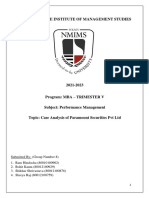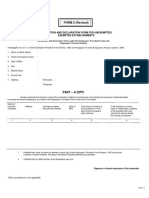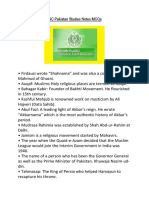Exploring The Picaresque: A Comparative Analysis of R.K. Narayan's 'The Guide' and Mulk Raj Anand's 'Coolie'
Exploring The Picaresque: A Comparative Analysis of R.K. Narayan's 'The Guide' and Mulk Raj Anand's 'Coolie'
Volume 9, Issue 5, May – 2024 International Journal of Innovative Science and Research Technology
ISSN No:-2456-2165 https://doi.org/10.38124/ijisrt/IJISRT24MAY2322
Exploring the Picaresque: A Comparative
Analysis of R.K. Narayan's 'The Guide' and Mulk
Raj Anand's 'Coolie'
Dr. Manju
Associate Professor
Aditi Mahavidhyalaya (Delhi University)
Abstract:- This research paper delves into the seminal While the picaresque tradition has its roots in Spanish
works of Indian literature, R.K. Narayan's "The Guide" literature, it has transcended geographical boundaries and
(1958) and Mulk Raj Anand's "Coolie" (1936), to influenced literary traditions worldwide. Adapted and
examine their portrayal of socio-cultural aspects of early reinterpreted by authors across cultures and epochs, the
20th-century Indian society. Narayan's novel is explored picaresque genre continues to evolve, adapting to
for its focus on spiritual and religious themes, while contemporary contexts while retaining its essential elements
Anand's work is analyzed for its depiction of poverty, of social critique, humor, and adventure.
exploitation, and social injustice experienced by the
lower classes. Through the lens of social realism, the In the realm of Indian literature, the picaresque
paper scrutinizes the significance of these novels in tradition finds resonance in works such as R.K. Narayan's
Indian writing in English, highlighting how Anand's "The Guide" and Mulk Raj Anand's "Coolie," where
"Coolie" serves as an early example of the picaresque protagonists navigate the complexities of Indian society,
novel in Indian literature. offering poignant insights into the human experience amidst
shifting social landscapes. Through their exploration of the
Keywords:- The Guide, Coolie, Indian Literature, Socio- picaresque, these novels not only entertain but also engage
Cultural Aspects. readers in a critical examination of societal norms and
values, making them enduring classics of Indian literature.
I. INTRODUCTION The significance of the picaresque genre in Indian literature
lies in its ability to offer a unique lens through which to
The picaresque genre, originating in Spain during the explore the complexities of Indian society, culture, and
16th century with works like "Lazarillo de Tormes," has identity. Here are several key points highlighting its
since traversed through literary landscapes, leaving an importance:
indelible mark on world literature. Characterized by its
episodic structure and the journey of a roguish protagonist Subversion of Traditional Narratives: Indian literature
through society's underbelly, the picaresque novel serves as has a rich tradition of epics, myths, and moralistic tales.
a mirror reflecting the social, political, and moral The picaresque genre provides a departure from these
complexities of its time. conventional narratives by focusing on the experiences
of marginalized and unconventional protagonists.
At its core, the picaresque narrative revolves around a Through their journeys, often marked by wit,
cunning, often marginalized protagonist—typically of low resourcefulness, and defiance, these characters challenge
social standing—who navigates through a series of established norms and values, offering a fresh
adventures and misadventures, encountering a colorful array perspective on Indian society.
of characters and situations along the way. These
protagonists, driven by survival instincts and a quest for Critique of Social Hierarchies: India's diverse social
upward mobility, offer a lens through which to explore the fabric, marked by caste, class, and religious divisions,
underprivileged strata of society and critique prevailing provides fertile ground for exploration within the
norms and institutions. picaresque tradition. Characters from lower socio-
economic backgrounds navigate through the stratified
The episodic nature of the picaresque novel allows for layers of society, shedding light on the injustices,
a diverse range of settings, from urban streets to rural prejudices, and inequalities prevalent in Indian life. By
landscapes, and enables authors to delve into various aspects portraying the struggles of these characters, picaresque
of society, often with a satirical or ironic tone. Through their novels critique entrenched power structures and advocate
escapades and encounters, these protagonists challenge for social change.
societal conventions, question authority, and subvert
established hierarchies, offering a subversive commentary
on the human condition.
IJISRT24MAY2322 www.ijisrt.com 2565
Volume 9, Issue 5, May – 2024 International Journal of Innovative Science and Research Technology
ISSN No:-2456-2165 https://doi.org/10.38124/ijisrt/IJISRT24MAY2322
Exploration of Colonial and Post-Colonial Realities: The Social Realism in the Guide and Coolie
picaresque genre emerged during a period of colonial Both Narayan and Anand were part of the generation of
expansion, and its themes of mobility, adaptability, and Indian writers who emerged in the 1930s and 1940s, writing
resistance are particularly resonant in the context of in English and addressing the social and political issues of
colonial and post-colonial India. Indian authors have their time. While Narayan's works are known for their gentle
employed the picaresque form to depict the experiences humor and portrayal of the middle-class life in the fictional
of individuals navigating through the tumultuous town of Malgudi, Anand's novels are characterized by their
transitions brought about by colonial rule, independence stark realism and focus on the lives of the underprivileged
movements, and the challenges of nation-building. sections of society.
Representation of Urbanization and Modernization: As Narayan and Anand indeed represent two distinct
India undergoes rapid urbanization and modernization, facets of Indian literature in English during the mid-20th
the picaresque genre offers a lens through which to century.
examine the complexities of urban life. Characters
traverse bustling cities, encountering a myriad of R.K. Narayan's literary world revolves around the
experiences that reflect the collision of tradition and fictional town of Malgudi, a microcosm of Indian society.
modernity, rural and urban worlds. Through their His works are imbued with gentle humor and warmth,
adventures, picaresque protagonists capture the offering insightful glimpses into the lives of ordinary people,
dynamism and contradictions of contemporary Indian especially those of the middle class. Narayan's narratives
society. often explore universal themes like family dynamics, social
norms, and the complexities of human relationships.
Engagement with Global Literary Traditions: The Through his vivid storytelling, he captures the essence of
picaresque genre, with its universal themes of survival, everyday life in India with a unique charm that resonates
resilience, and the search for identity, facilitates dialogue with readers across generations.
with global literary traditions. Indian authors, drawing
inspiration from the picaresque tradition, contribute to a On the other hand, Mulk Raj Anand's writing is
broader conversation on literature and society, enriching characterized by its unflinching realism and social
the diversity of voices in the global literary landscape. commentary. His novels delve into the harsh realities faced
by the underprivileged and marginalized sections of society.
In summary, the picaresque genre enriches Indian Anand's works shed light on issues such as poverty, caste
literature by offering a platform for marginalized voices, oppression, and the struggle for social justice. Through his
critiquing social injustices, and engaging with the gritty portrayals and compassionate storytelling, Anand
complexities of Indian society. Its significance lies in its confronts readers with the harsh truths of life for many
ability to provide a nuanced understanding of Indian life Indians, challenging societal norms and advocating for
while fostering connections with broader literary traditions. empathy and change.
R.K. Narayan's novel The Guide (1958) and Mulk Raj Despite their divergent approaches, both Narayan and
Anand's novel Coolie (1936) are two seminal works of Anand contributed significantly to the rich tapestry of Indian
Indian literature that explore the socio-cultural aspects of literature, offering nuanced perspectives on the complexities
Indian society in the early 20th century. While Narayan's of Indian society and human existence. Their works continue
novel focuses on the spiritual and religious themes, Anand's to inspire and resonate with readers worldwide, showcasing
work delves into the harsh realities of poverty, exploitation the enduring power of literature to illuminate the human
and social injustice faced by the lower classes. experience.
In The Guide, Narayan explores the themes of
While both novels offer profound insights into Indian spirituality, religion and the role of the individual in society
society, they approach their subjects from different angles. through the character of Raju, a tourist guide who becomes a
"The Guide" focuses more on individual introspection and spiritual leader. The novel also touches upon social evils
spiritual quest, while "Coolie" provides a stark portrayal of like casteism, inequality and gender bias. On the other hand,
systemic oppression and social injustice. Together, they Anand's Coolie is a scathing indictment of the exploitation
contribute to a rich tapestry of Indian literature, offering of the poor by the rich and powerful. The novel follows the
diverse perspectives on the complexities of the human journey of Munoo, a young boy from the hills who is forced
condition. to work as a coolie (manual laborer) in various cities, where
he faces exploitation, abuse and ultimately, death.
This research paper aims to analyze these two novels
through the lens of social realism and examine their
significance in the context of Indian writing in English. It
will also discuss how Anand's Coolie can be considered as
one of the earliest examples of the picaresque novel in
Indian literature.
IJISRT24MAY2322 www.ijisrt.com 2566
Volume 9, Issue 5, May – 2024 International Journal of Innovative Science and Research Technology
ISSN No:-2456-2165 https://doi.org/10.38124/ijisrt/IJISRT24MAY2322
II. COOLIE AS A PICARESQUE NOVEL [5]. Garrido Ardila, J. A. (2015). Origins and definition of
the picaresque genre. In J. A. Garrido Ardila (Ed.), The
The picaresque novel is characterized by its episodic Picaresque Novel in Western Literature: From the
structure, with the protagonist traveling from place to place Sixteenth Century to the Neopicaresque (pp. 1–23).
and encountering various social classes and situations along Cambridge University Press.
the way. These novels often provide a satirical commentary [6]. Kawan, G., Mohammed, R., & Pub, A. (2024). A study
on society, highlighting the hypocrisy and corruption of the of Mulk Raj Anand’s contribution to English literature
ruling class while sympathizing with the plight of the lower in general and society in particular. International
classes. Journal of Multidisciplinary Research and Growth
Evaluation, 05, 341–345.
Coolie can be considered as one of the earliest [7]. Picaresque Definition & Meaning—Merriam-Webster.
examples of the picaresque novel in Indian literature. The (n.d.). Retrieved May 13, 2024, from
picaresque novel is a genre that originated in Spain in the https://www.merriam-
16th century and features a roguish hero who travels from webster.com/dictionary/picaresque
place to place, encountering various adventures and
misfortunes. Anand's novel follows this structure, with
Munoo moving from one city to another, working in various
jobs and facing a series of hardships and misfortunes.
The novel also features other characteristics of the
picaresque genre, such as a satirical portrayal of society and
its institutions, and a focus on the lower classes and their
struggles. Anand's novel is a scathing critique of the social
and economic inequalities that existed in colonial India, and
a call for social reform and justice.
III. CONCLUSION
In conclusion, R.K. Narayan's The Guide and Mulk Raj
Anand's Coolie are two important works of Indian literature
that explore the socio-cultural aspects of Indian society in
the early 20th century. While Narayan's novel focuses on
spiritual and religious themes, Anand's work delves into the
harsh realities of poverty, exploitation and social injustice
faced by the lower classes.
Coolie can also be considered as one of the earliest
examples of the picaresque novel in Indian literature, with
its focus on the journey of a roguish hero and its satirical
portrayal of society and its institutions. Both novels are
important contributions to the canon of Indian writing in
English and continue to be studied and discussed by scholars
and readers alike.
REFERENCES
[1]. Anand, M. R. (1945). Coolie. INDIA : penguin books.
[2]. Bhatt, J. (Volume 8, Special Issue 4, February 2023).
THE CONCEPT OF SOCIO-CULTURAL ASPECTS
IN R.K. Vidhyayana:An International Multidisciplinary
Peer-Reviewed E-Journal, 1-7.
[3]. Khuman, P. (2010). SOCIAL REALISM IN MAJOR
NOVELS OF. india: Saurashtra University Theses
Service .
[4]. T, B. (2017). Mulk Raj Anand'S Coolie As A Social
Tragedy. india : ST THOMAS COLLEGE
THAVALAPPARA,
KONNI,PATHANAMTHITTA,KERALA- 689691.























































































































